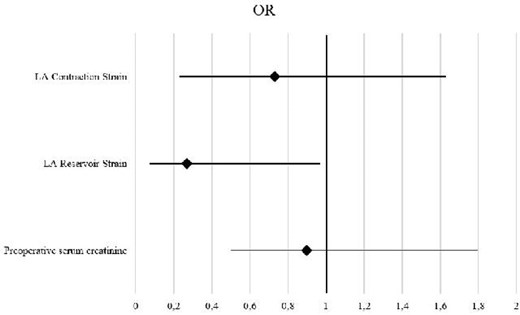-
Views
-
Cite
Cite
A Grasso Granchietti, N Ciardetti, C Mazzoni, M Garofalo, R Mazzotta, S Micheli, M Chiostri, M Orlandi, L Biagiotti, S Del Pace, C Di Mario, S Caciolli, LEFT ATRIAL STRAIN AND RISK OF ATRIAL FIBRILLATION AFTER CORONARY ARTERY BYPASS–GRAFTING, European Heart Journal Supplements, Volume 27, Issue Supplement_5, May 2025, suaf076.054, https://doi.org/10.1093/eurheartjsupp/suaf076.054
Close - Share Icon Share
Abstract
Aim
Postoperative Atrial Fibrillation (POAF) is a common complication following Coronary Artery Bypass Grafting (CABG), associated with increased morbidity and mortality. Despite numerous studies, predicting which patients will develop POAF remains challenging. Aim of the study is to analyze whether the measurement of preoperative Left Atrial (LA) strain can offer advantages over conventional clinical and echocardiographic parameters, to identify patients at risk of developing POAF after CABG.
Methods and results
We conducted a prospective study involving 100 patients undergoing isolated CABG from April 2023 to April 2024. Exclusion criteria included current or previous AF, significant valvular disease, prior cardiac surgery and congenital heart disease. Comprehensive preoperative transthoracic echocardiography was performed, and continuous rhythm monitoring was maintained until hospital discharge. Key parameters measured included LA strain measurements, Left Atrial Emptying Fraction (LA–EF), Left Ventricular Ejection Fraction (LVEF), Left Atrial Volume index (LAVi). POAF occurred in 27 patients (27%) with a mean latency of 3.2 ± 2.1 days. Higher preoperative serum creatinine levels were significantly associated with POAF. LA strain parameters (LA Reservoir Strain, LA Contraction Strain) and LA–EF were all significantly lower in the POAF group. Multivariate logistic regression identified LA Contraction Strain (OR: 0.73, p=0.04), LA Reservoir Strain (OR: 0.27, p=0.02) and preoperative serum creatinine (OR: 0.55, p=0.01) as significant predictors of POAF (Figure 1). ROC curve analysis indicated that LA Reservoir Strain ≤ 24.5%, LA Contraction Strain ≤ 9.5%, LA–EF ≤ 43.4% have a good accuracy in detection of POAF (Figure 2). Significant correlations were found between LAVi and LA Reservoir Strain, LAVi and LA–EF, and LA Reservoir Strain and LA–EF. Additionally, preoperative serum creatinine showed significant negative correlation with LA Reservoir Strain and positive correlation with LAVi.
Conclusions







